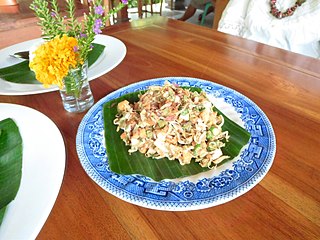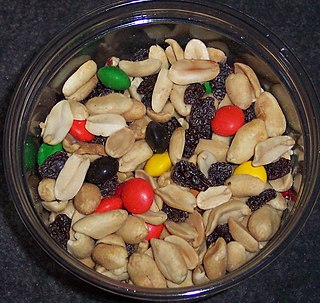
A banana chip is a deep-fried or dried, generally crispy slice of banana. It is usually made from firmer, starchier banana varieties like the saba and Nendran cultivars. It can be sweet or savory and can be covered with sugar, honey, salt, or various spices.

Indonesian cuisine is a collection of various regional culinary traditions that formed in the archipelagic nation of Indonesia. There are a wide variety of recipes and cuisines in part because Indonesia is composed of approximately 6,000 populated islands of the total 17,508 in the world's largest archipelago, with more than 1,300 ethnic groups.

Gnetum gnemon is a gymnosperm species of Gnetum, its native area spans from Mizoram and Assam in India down south through Malay Peninsula, Malay Archipelago and the Philippines in southeast Asia to the western Pacific islands. Common names include gnetum, joint fir, two leaf, melinjo/belinjo (Indonesian), bago (Filipino), and tulip.

A rice cracker is an East Asian cracker made from bleached or unbleached rice flour. Many regional varieties exist, though most are fried or baked and puffed and/or brushed with soy sauce or vinegar to create a smooth texture. Some may also be wrapped in seaweed.

Lontong is an Indonesian dish made of compressed rice cake in the form of a cylinder wrapped inside a banana leaf, commonly found in Indonesia, Malaysia, and Singapore. Rice is rolled inside a banana leaf and boiled, then cut into small cakes as a staple food replacement for steamed rice. The texture is similar to that of ketupat, with the difference being that the ketupat container is made from woven janur fronds, while lontong uses banana leaf instead.

Javanese cuisine is the cuisine of Javanese people, a major ethnic group in Indonesia, more precisely the province of Central Java, Yogyakarta and East Java.

Rengginang or ranginang is a variety of Indonesian thick rice crackers, made from cooked glutinous sticky rice and seasoned with spices, made into a flat and rounded shape, and then sun-dried. The sun-dried rengginang is deep-fried with ample cooking oil to produce a crispy rice cracker.

Krupuk kulit is a traditional Indonesian cattle skin krupuk (cracker). It is traditionally made from the soft inner skin of cattle which is diced and sun-dried until it hardens and loses most of its water content. The diced and dried skin are later fried in ample hot cooking oil until they expand similarly with bubbles and yield a crispy texture. This fried cattle skin is then sealed in vacuum plastic bags to ensure and prolong its crispiness.

Betawi cuisine is rich, diverse and eclectic, in part because the Betawi people that create them were composed from numbers of regional immigrants that came from various places in the Indonesian archipelago, as well as Chinese, Indian, Arab, and European traders, visitors and immigrants that were attracted to the port city of Batavia since centuries ago.

Ketupat, or kupat, or tipat is a Javanese rice cake packed inside a diamond-shaped container of woven palm leaf pouch. Originating in Indonesia, it is also found in Brunei, Malaysia, Singapore, southern Philippines, southern Thailand, Cambodia and Laos. It is commonly described as "packed rice", although there are other types of similar packed rice such as lontong and bakchang.

Kripik or keripik are Indonesian chips or crisps, bite-size snack crackers that can be savoury or sweet. They are made from various dried fruits, tubers, vegetables, and fish that have undergone a deep frying process in hot vegetable oil. They can be lightly seasoned with salt, or spiced with chili powder and sugar.

Krupuk (Javanese) is an Indonesian deep fried crackers made from starch and other ingredients that serve as flavouring. They are a popular snack in parts of Southeast Asia, but most closely associated with Indonesia. Kroepoek also can be found in the Netherlands, through their historic colonial ties with Indonesia.

Karedok is a raw vegetable salad in peanut sauce from Sundanese region, West Java, Indonesia. It is one of the Sundanese signature dish. It traditionally includes longbeans, cucumbers, bean sprouts, cabbage, legumes, lemon basil, chayotes and small green eggplant, covered in peanut sauce dressing, but there are now many variations. It is very similar to gado-gado, except all the vegetables are raw, while most of gado-gado vegetables are boiled, and it uses kencur, lemon basil and eggplant. Karedok is also known as lotek atah for its fresh and raw version of the vegetable covered with peanut sauce. Karedok is widely served as daily food in the Sundanese family, usually eaten with hot rice, tofu, tempeh, and krupuk. Nowadays karedok can be found in many variation from hawkers carts, stalls (warung) as well as in restaurants and hotels both in Indonesia and worldwide.

Gado-gado is an Indonesian salad of raw, slightly boiled, blanched or steamed vegetables and hard-boiled eggs, boiled potato, fried tofu and tempeh, and sliced lontong, served with a peanut sauce dressing.

Prawn crackers are a deep-fried snack made from starch and prawn. They are a common snack food in Southeast Asian cuisine, but they are most closely associated with Indonesia. They have also been adapted into East Asian cuisines, where the similar Japanese kappa ebisen (かっぱえびせん) and Korean saeukkang are popular snacks.

A snack is a small portion of food generally eaten between meals. A snack is often less than 200 calories, but this can vary. Snacks come in a variety of forms including packaged snack foods and other processed foods, as well as items made from fresh ingredients at home.

Bawang goreng is an Indonesian crispy fried shallot condiment, commonly deep-fried, and a popular garnish to be sprinkled upon various dishes of Indonesian cuisine. It is quite similar to a crisp fried onion.



















